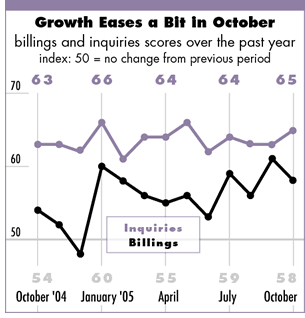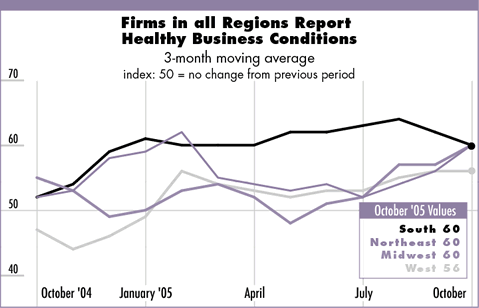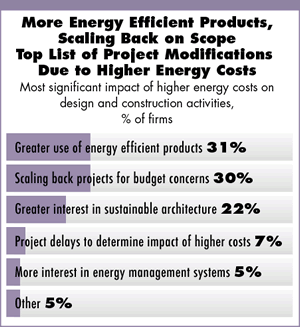

11/2005
Despite rising energy costs, most firms reporting minor changes in project design

by
Kermit Baker, PhD, Hon. AIA
Chief Economist
 Though the pace of growth slowed a bit from September,
business conditions at U.S. architecture firms in October improved for
the tenth straight month. The October reading of 57.5 (any reading above
50 in the Architecture Billings Index indicates growth in billings nationally)
represents a somewhat slower pace of growth than the 60.5 score in September,
but is ahead of the 57.1 average reading for the first 10 months of 2005.
Additionally, the index reading for inquiries for new work jumped to
64.8, the third highest reading of the year, indicating strong interest
in future design projects.
Though the pace of growth slowed a bit from September,
business conditions at U.S. architecture firms in October improved for
the tenth straight month. The October reading of 57.5 (any reading above
50 in the Architecture Billings Index indicates growth in billings nationally)
represents a somewhat slower pace of growth than the 60.5 score in September,
but is ahead of the 57.1 average reading for the first 10 months of 2005.
Additionally, the index reading for inquiries for new work jumped to
64.8, the third highest reading of the year, indicating strong interest
in future design projects.
Firms in all regions of the country report healthy business conditions. For firms in the Northeast and Midwest, conditions have strengthened considerably in recent months. For firms in the West, growth has begun to level off, while firms in the South have seen a slight easing in growth after several months of reporting the strongest growth of any region.
Commercial/industrial firms are reporting the strongest growth in billings in recent months, pointing to acceleration in construction activity in this sector around the middle of 2006. Institutional firms are reporting stable growth, while residential firms are reporting growth easing.

Hurricanes’ effects
still felt
The broader economy is still battling its way out of the slowdown resulting
from the recent hurricanes. After increasing by almost 200,000 payroll
jobs per month on average through the first eight months of the year,
employment declined nationally by 8,000 jobs in September and increased
by only 56,000 in September. Construction, fortunately, has not suffered.
Construction payrolls increased in September and again in October.
The October gain of 33,000 payroll positions accounted for over half
of the job gains nationally last month.
The consumer outlook has also suffered over this period, in part due to rising energy costs. After declines in the consumer sentiment index in August, September, and October, the preliminary November reading shows a reasonably healthy rebound. Whether this will be enough to strengthen retail spending remains to be seen. Retail sales growth has been slowing in recent months, and, as of October, retail sales were up only 5.6 percent as compared to year-ago levels.
 Energy costs hurting the industry
Energy costs hurting the industry
Rising energy costs have negatively affected the design and construction
industry in several ways. By slowing the broader economy, they limit
the need for new facilities. By increasing transportation costs, they
have added to delivery costs of construction products. Finally, construction
products and materials that have a high petroleum content (e.g., asphalt
shingles and PVC piping) have seen direct price increases.
Still, fewer than 40 percent of firms report that rising energy costs have changed the way that they approach design projects. The areas where firms report the most significant impact are: greater use of energy-efficient products (31 percent), scaling back on projects due to increased construction costs resulting from higher energy costs (30 percent), and greater interest in sustainable architecture to reduce longer-term energy costs (22 percent). Fewer firms mentioned more significant impacts like delaying projects, investing in energy management systems in new buildings, or changing product specifications in projects.
Copyright 2005 The American Institute of Architects.
All rights reserved. Home Page ![]()
![]()
 |
||
This month, Work-on-the-Boards survey participants are saying: • The biggest worry on the horizon is construction cost
inflation. • Contractors are telling me that they are going into the
winter without backlogs. Next year will be decided for us in the
next 60 days. • Things here still very steady. We are busy and continue
to have work coming in at a good pace with a lot of projected work
for 2006.
|
||